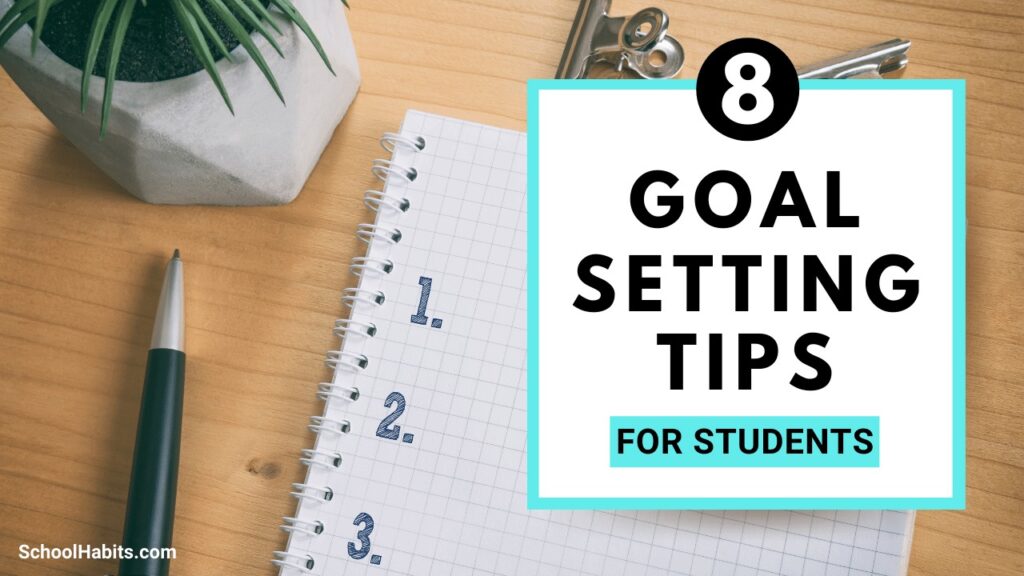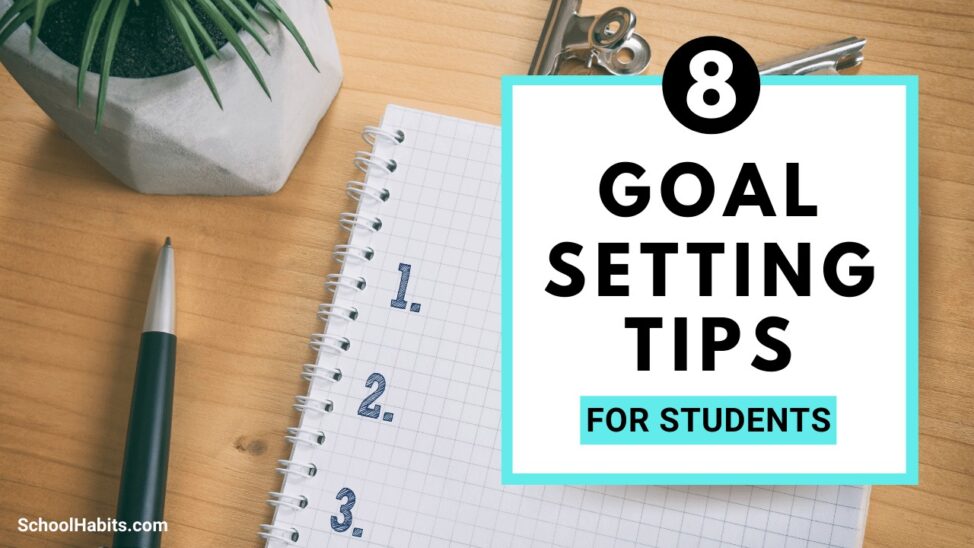By Katie Azevedo, M.Ed.

This tutorial offers 8 goal-setting tips for students, although many of the tips are solid strategies for goal-setting in general – for anyone.
Goal-setting is all the rage around the new year, but I think most of that is simply traditional marketing hype. We can set goals any time of year, and we should be thinking about and revising our goals all year long.
I write about goal setting a lot, as the ability to set goals and meet them falls under the domain of executive functions, which is what I teach. If you’re a student and you’re looking for some ideas for goals to set, start with this list here.
Goal-setting tips for students
The following goal-setting strategies can help you figure out what goals to set and how to reach them. The more tips you use, the more likely you’ll reach your goals – but starting with just one strategy is better than using none.
1. Consider goal categories.
Think about setting goals for different areas of your life. I suggest students think about the following 4 categories when setting goals for themselves:
- Academic
- Personal
- Health
- Relationships
2. Stick to 1-3 goals.
According to the Oxford Dictionary, a goal is “the object of a person’s ambition or effort; an aim or desired result.” Therefore, the more goals you set, the more effort you have to exert in multiple directions – and the more exhausted and unfocused you’ll be. Aim to set between 1 and 3 goals so you don’t burn out; you can set goals in multiple categories (above) or all from the same category.
3. Target your strengths and weaknesses.
If you’re struggling to figure out what goal to set, start by evaluating your strengths and weaknesses. Successful goals often target one of the following:
- Improve areas of weakness
- Expand on strengths
For example, if you know your study habits are junk (area of weakness), then set a goal to learn and practice 3 new study methods this semester. Or if you’re already a really organized student (area of strength), then set a goal to become organized in another area of your life.
4. Write down your goals.
A goal that exists only in your head is just a hope. Writing down your goals forces you to make them clear and concise. Write them on a sticky note and stick it to your desk, keep them hidden on a piece of paper that you store in the back of your nightstand drawer, or use my goal-setting printables that are designed exactly for this purpose. (This is my own personal system that I’ve used for years.)
5. Track your goals.
If your goal isn’t measurable, it’s not a good goal to begin with. (Maybe you’ve heard of S.M.A.R.T. goals?) So assuming your goal is somehow measurable, you should track the progress you make over time. Is your goal to learn 3 new study techniques? Keep track of what they are, when you use them, and how they work for you. Is your goal to improve your biology grade? Keep track of how many assignments you miss, your quiz grades, how many days you stay after with your teacher, etc. Use a digital goal-tracking app (there are approximately one bazillion of them) or a simple notebook.
6. Revise your goals regularly.
This goal-setting tip goes with the one above (tracking your goals). If you’re tracking your goals, you’ll gain insight into whether or not you’re making progress. You need this feedback so you can revise your goals if needed. Sometimes we set the wrong goal for ourselves – and that’s okay! The important thing is to recognize when you’re going off course, and then adjust your goals as often as you need to. If you realize you’ve set the wrong goal, it’s better to revise it or start over completely than to waste your efforts on the wrong target.
7. Start backward.
Starting from your desired end result (your goal), work backward to where you are now: what are the steps in between point A and point B? Map them out. Write them down. This process is called reverse engineering, it’s basically magic, and I teach you exactly how to do it right here.
8. Set goals for 1 month, 3 months, and 6 months.
Setting goals for a whole year is very ambitious and insanely difficult. So much can happen in a year that has the potential to derail us, and there’s a lot we can’t control or predict over that amount of time. I suggest setting goals for smalling time frames, such as 1 month, 3 months and 6 months. Smaller time frames are not only easier to manage, but they offer more opportunities to set and meet your goals; the more goals you set and meet, the more you prove to yourself that you can do this.
Goal-setting tips for students are similar to goal-setting strategies for non-students, but the difference is that most students are newer to setting goals than are people in the workforce. (Yes, there are exceptions to this rule.) Therefore, I wrote these tips with the beginner in mind because the basics matter more than anything.

